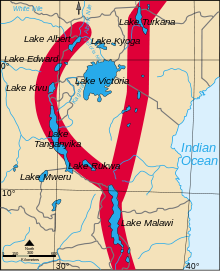Great Rift Valley




The Great Rift Valley or East African Rift is a continuous geographical trench, about 6,440 kilometres (3,700 mi) in length, that runs from northern Syria in Southwest Asia to central Mozambique in East Africa. The rift is bordered by a series of mountains and active volcanoes. It is a site of faults and earthquakes.
Basically, the western part of Africa is rifting away from the eastern part. This causes all the geological activity at the Valley. Far in the future, a sea will run between these two parts of Africa. The Arabian peninsula is already almost separated. The whole process is part of plate tectonics. In eastern Africa, the valley divides into two, the Western Rift Valley and the Eastern Rift Valley.
There are about 20 UNESCO World Heritage Sites which owe their formation to the geography and geology of the Great Rift Valley.
The Western Rift Valley[change | change source]
The Western Rift is edged by some of the highest mountains in Africa. It contains the Rift Valley lakes, which include some of the deepest lakes in the world (up to 1,470 metres deep at Lake Tanganyika). Much of this area is inside national parks.
The African Great Lakes are a series of lakes formed by the tectonic action of the East African Rift. Most lie within its rift valley.. They include Lake Victoria, the second largest fresh water lake in the world in terms of surface area, and Lake Tanganyika, the world's second largest in volume as well as the second deepest.
The African Great Lakes are divided among three different catchments (river basins). Some, such as Lake Turkana, have internal drainage systems. The largest, in order of size from largest to smallest are:
- Lake Victoria
- Lake Tanganyika
- Lake Malawi (Lake Nyasa)
- Lake Turkana (Lake Rudolf)
- Lake Albert
Eastern Rift Valley[change | change source]
The lakes in the Eastern Rift have no outlet to the sea and tend to be shallow, they have a high mineral content as the evaporation of water leaves the salts behind.
Lake Malawi (or Lake Nyasa: the name is disputed) is the most southern of the Great Lakes, and empties into the great Zambezi River via the Shire River.
Other websites[change | change source]
 Media related to Great Rift Valley at Wikimedia Commons
Media related to Great Rift Valley at Wikimedia Commons- The Ethiopian Rift Valley Archived 2019-11-20 at the Wayback Machine
- Rift! Geologic clues to what's tearing Africa apart (YouTube
